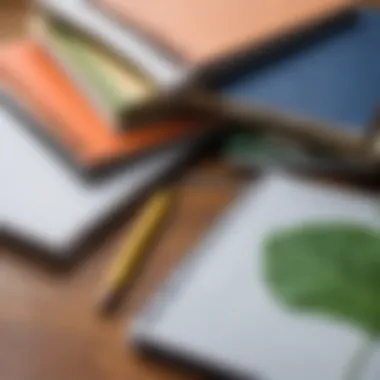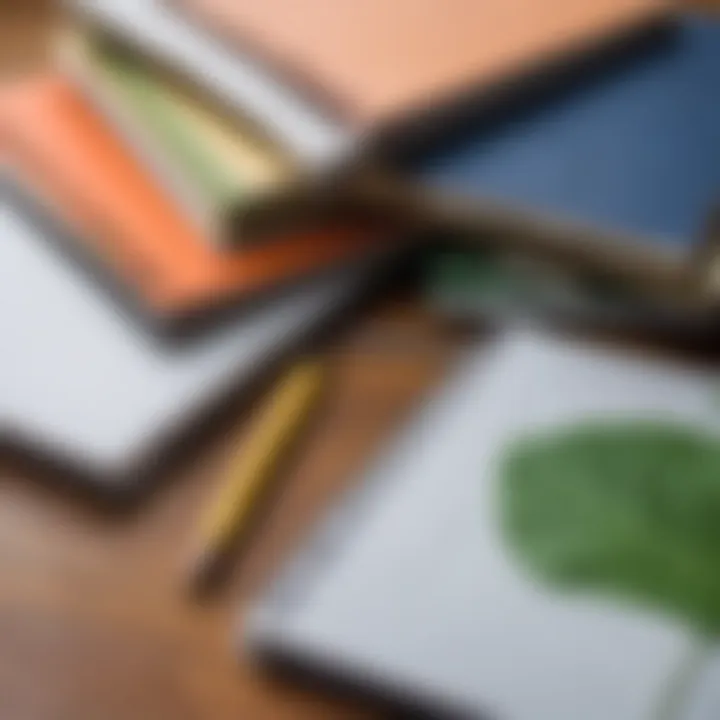The Importance of School Notebooks in Education


Intro
In the realm of education, school notebooks often serve as understated yet pivotal tools that cater to both students and educators alike. The journey through academic life is replete with thoughts, ideas, and reflections, and what better way to document these than through the pages of a chosen notebook? Notebooks have long been considered essential tools in schools, acting not just as a mere collection of blank pages, but as companions that contribute to the learning process.
A historical glance reveals that notebooks have evolved significantly, adapting to the needs of their users across generations. From simple lined pages for jotting down notes to vibrant, themed covers that engage young minds, these tools have become more than just their physical forms. They encapsulate memories, innovations, and, importantly, a child’s academic growth.
Dive deeper into what makes a school notebook more than just a series of sheets bound together. Notebooks display varying types—spiral-bound, hardcover, or even digital formats—that appeal to different demographics. Educators, students, and parents derive unique benefits based on these choices. Some prefer eco-friendly options, which reflect a growing awareness of sustainability. Others may focus on organization features that promote effective studying and note-taking.
As we venture further into this exploration, we'll discover not only the historical context and types of notebooks, but also the nuances connecting aesthetics with functionality. This is vital in understanding how notebooks function as not just tools—but as facilitators of learning.
Nestled between practicality and beauty, each choice made in selecting a notebook impacts the learning environment in some form, whether it's the choice of paper weight or cover design. Thus, understanding the significance of school notebooks unveils deeper implications for educational strategies. Through this comprehensive overview, we aim to inform our readers, who include students and young professionals, families with children, and those mindful of budgetary constraints.
Let’s embark on this intricate journey, uncovering the essential roles these notebooks play and the considerations of artful design and practicality, all while minding our ecological footprint.
Historical Perspective of School Notebooks
Notebooks have been a staple in education for centuries, yet their significance often goes unnoticed. The historical perspective on school notebooks sheds light on their evolution and cultural relevance, highlighting not just how we document learning but also how we shape it. Studying this trajectory provides essential insights into how these tools have facilitated knowledge transfer, supported different educational philosophies, and adapted to both technological advancements and cultural shifts.
Evolution Through Ages
The journey of school notebooks started way back in ancient civilizations. In Mesopotamia, scribes recorded information on clay tablets, using styluses to engrave symbols that conveyed complex ideas. Fast forward to the Renaissance, and we see a shift with the introduction of paper from Japan reaching Europe. This material sparked an educational revolution. Notebooks, made from this new paper, became more accessible to the burgeoning class of scholars and later to students.
As we moved into the 19th century, the formalization of educational systems created a demand for structured note-taking. Different designs emerged: ruled pages for organized thoughts, blank pages for creative expression, and even graph paper for mathematical prowess. During this time, notebooks transitioned from mere writing tools to companions of the educational journey.
"The evolution of notebooks reflects broader shifts in learning practices, illustrating how documentation adapt changes in thought and culture."
By the time we reached the 20th century, spiral notebooks made their debut, offering practicality and flexibility. This innovation allowed students to easily tear out pages and reshape their notes, marking a significant convenience in education. The introduction of colorful covers and themed designs reflected the growing personalization of learning materials; no longer were notebooks just functional—they were also a means of self-expression.
Cultural Variations in Note-taking
While the basic function of notebooks is similar across cultures—serving as a space for thought and reflection—note-taking practices can vary widely. In Japan, for instance, students use buntan notebooks, which are often densely filled with calligraphic writing, reflecting a cultural emphasis on aesthetic presentation and precision. This contrasts sharply with regions where rapid note-taking is prioritized, creating a more utilitarian approach, such as the popular Cornell method in some Western classrooms.
Line spacing, margins, even the type of pen used can highlight distinct learning environments and priorities. In cultures where collective learning is emphasized, shared notebooks are common. Group projects often see students collaboratively filling these shared books, which lend themselves well to cooperative learning methodologies.
Additionally, recent trends show a resurgence in analog note-taking methods even as digital solutions spread. Many students knowingly incorporate various elements from their cultural backgrounds into how they document their knowledge. This illustrates the adaptability of notebooks in aligning with individual and cultural identities, reaffirming their significance as not just tools, but as cultural artifacts that mirror the values and priorities of the societies in which they are used.
Types of School Notebooks
Understanding the various types of school notebooks truly opens a window into their significance in the educational landscape. Notebooks are more than just sheets of paper held together by a cover; they are tools for organization, creativity, and personal expression. The market is rife with different varieties, each designed to meet specific needs and cater to diverse preferences. Choosing the right type of notebook can greatly enhance learning experiences and help students engage deeper with their subjects.
Spiral vs. Bound Notebooks
When it comes to notebooks, two predominant types often come to mind: spiral and bound notebooks. Each has distinct characteristics that can influence a student's choice based on their study habits or particular needs.
A spiral notebook is typically composed of loose sheets held by a spiral coil on one side. This design offers versatility; pages can be turned easily, and the ability to fold the notebook back on itself allows for a more comfortable writing experience.
On the other hand, bound notebooks usually feature pages that are glued or stitched together, giving them a sturdier feel. They maintain a more professional appearance, proving advantageous for contexts where neatness is of the essence. However, once a page is written on and turned, it can be difficult to reference past notes without flipping through the whole book.
Choosing between these two can come down to individual needs:
- If you enjoy flexibility and frequent reorganization, spiral notebooks could be your go-to.
- For those who prefer a clean, traditional look or require a notebook that withstands rough handling, bound notebooks may be the better option.
Specialized Notebooks for Subjects
While general notebooks serve a wide range of purposes, there are specialized notebooks designed for specific subjects that elevate note-taking to new heights. These notebooks cater to the unique demands of disciplines such as mathematics, science, and art, ensuring that students have the right tools at their fingertips.
For example, a graphing notebook is invaluable in mathematics; its grid pattern aids in plotting functions and visualizing problems more effectively. In the realm of science, lab notebooks come equipped with features like chemical-resistant pages and space for diagrams, encouraging meticulous documentation of experiments.
Art students might lean towards sketchbooks, often filled with thicker, textured pages that can handle a variety of mediums, from pencil to paint.
These specialized notebooks not only support better learning through targeted features but also help students develop a deeper understanding of their subjects. Investing in the right type of notebook can streamline study sessions and foster creativity.
"Notebooks, whether general or specialized, serve as an extension of a student's mind, capturing thoughts and enhancing learning."
Both categories of notebooks play vital roles in education, bolstering not just performance but also engagement. In a world where distractions are rampant, a well-chosen notebook can help a student focus, organize their thoughts, and thrive academically.
Features of a Good School Notebook
When discussing school notebooks, we can’t overlook the integral features that truly define a good notebook. A quality notebook can make or break the learning experience, serving as a reliable companion for students on their educational journey. The importance of well-crafted notebooks extends beyond mere aesthetics; they facilitate note-taking, promote organization, and support creativity. Understanding what constitutes a good school notebook—its paper quality, durability, design, and layout—empowers students and parents alike to make informed choices.
Paper Quality and Durability
One of the cornerstone features of a good school notebook is its paper quality. High-quality paper allows ink to flow smoothly, preventing smudging and bleeding. This is particularly crucial for students who utilize various writing instruments—from gel pens to markers. If the ink seeps through, it may render the opposite page unusable, wasting valuable space. Notebooks made from acid-free paper can also withstand the test of time, preserving notes for future reference without yellowing or deteriorating.
The durability of a notebook is equally vital. A well-constructed notebook can endure the daily wear and tear of student life, from being tossed in backpacks to surviving accidental spills. When choosing a notebook, opt for features like reinforced spines or thicker covers to enhance longevity. This way, students can focus on their studies without worrying about their notes falling apart.
Design and Layout Considerations
The design and layout of a school notebook play a significant role in how effectively a student engages with their notes. A thoughtful layout can help students organize their thoughts, aiding comprehension and retention. For instance, notebooks featuring grid or dotted pages offer flexibility, making them suitable for both writing and sketching.
Moreover, customizable covers can give students a sense of ownership, allowing them to express their individuality. Personalization can enhance emotional connection to the notebook, making it more likely that they will use it regularly.
It’s also important to consider the size and portability of the notebook. A lightweight, compact design can easily fit into a student’s bag, making it convenient to carry from class to class.
"Choosing the right notebook is an investment in your learning process. It’s about creating an environment that fosters effective note-taking and organization."
Demographics and Preferences


Understanding the demographics and preferences related to school notebooks is essential in appreciating how these tools fit into the broader educational landscape. Notebooks serve not only as a medium for note-taking but also as a reflection of individual choices influenced by age, educational level, and family values. They embody a bridge between personal expression and functionality. As students progress through their education, their needs and preferences evolve, impacting the type of notebooks they choose. This discussion shines a light on two primary aspects: the preferences of students at different stages and the insights parents offer regarding choices that shape those preferences.
Student Preferences: Age and Educational Level
At different educational milestones, students exhibit varying inclinations towards the type of notebooks they favor. For instance, younger students in elementary school often gravitate towards colorful spiral-bound notebooks adorned with cartoons or popular characters. These notebooks are not just tools; they carry a sense of identity, providing a space for creativity and expression in an often-structured environment.
• Elementary Level: Colorful designs attract younger children, making learning fun. • Middle School: As students shift into middle school, their needs become more complex. Notebooks that offer a blend of design and functionality come into play. Here, students tend to choose designs that reflect their emerging identities, often favoring larger, more organized binders or notebooks that allow them to keep subjects separated.
• High School: By high school, preference shifts towards practicality. Students at this level often lean towards durable options, such as hardcover notebooks or those with a professional look, as they prepare for college. Their focus is on efficiency—having the right number of pages per subject, along with features like perforated edges or removable sheets.
Such transitions illustrate how notebooks play into a student's educational journey, as changes in their organizational needs and aesthetic preferences shift over time. Age-centric choices not only impact functionality but could also affect how engaged a student feels with their studies.
Parental Insights on Choice
Parents have a crucial role in guiding their children's choices when it comes to notebooks. Their insights often stem from a blend of experience, an understanding of educational requirements, and the desire to foster good habits in their children. For families, practical considerations come into play, such as durability, price, and sustainability. These factors can significantly influence which products end up in the school bag.
• Value for Money: Parents often seek notebooks that are affordable without compromising on quality. They tend to invest in products that are both cost-effective and durable, especially if their child tends to go through materials quickly. • Educational Guidance: Parents consider factors like ease of note-taking when selecting notebooks for their children. With rising concerns about digital distractions, many parents prefer traditional paper notebooks, believing they encourage better retention and higher engagement in class. • Sustainability Awareness: An increasing number of parents are becoming conscious of the environmental impact of their purchases. They often look for brands that use eco-friendly materials or sustainable practices in their production processes. This choice reflects a broader cultural understanding around sustainability that they wish to pass on to their kids.
"Helping kids choose the right school notebook is not just about aesthetics but about fostering a responsible and organized approach to learning—a small investment today lays the groundwork for their future habits."
In summary, the demographics and preferences regarding school notebooks illustrate the intricate relationship between students and these educational tools. By understanding how age and parental preferences shape choices, we can better appreciate the pivotal role that these seemingly simple items play within the educational sphere.
Functionality in Education
When we talk about the role of notebooks in education, we must first consider their functionality. After all, these tools do not just exist to collect dust. Instead, they play a vital part in how students absorb, organize, and reflect upon information. Notebooks are not merely pages bound together; they are instruments of learning that help shape a student's academic journey.
Notebooks as Learning Tools
At their core, notebooks serve as primary learning tools in various educational settings. They are spaces where thoughts and ideas come to life. Whether a student is sketching diagrams for a science project or jotting down key points during a history lecture, these notebooks function as mind maps. When students write by hand, it boosts comprehension and retention. Cognitive research indicates that the act of writing enhances memory; it’s as if thoughts get to settle into the brain while pen meets paper.
One account from an art student highlights this quite effectively. While preparing for an exhibition project, she utilized a mix of sketches, notes, and spontaneous ideas all crammed into one notebook. This encouraged her creative flow and provided a tangible record of her progress. The notebook was not merely a collection of sketches; it turned into a storytelling medium for her artistic evolution. This example illustrates how notebooks can empower students to track their learning journey.
Encouraging Critical Thinking through Notes
Critical thinking is another cornerstone of effective education, and notebooks play an essential role in honing this skill. When students engage actively in note-taking—by summarizing information, raising questions, or mapping out arguments—they are not just passive recipients of knowledge. Instead, they become involved in a dialogue with the subject at hand. For instance, during a literature class discussion, students may note their reflections on characters or themes, allowing them to analyze rather than just memorize.
"The best notebook is one that transforms into a conversation between the student and the subject, leading to deeper understanding."
Equipped with a notebook, students can practice synthesizing information. This means they not only pull together various ideas but also connect them to prior knowledge. When reading about historical events, students can draw lines or arrows in their notebooks, showing relationships and influences. As a result, it's easier to see patterns and draw conclusions, paving the way for insightful discussions later on.
Aesthetics and Personalization
Aesthetics and personalization in school notebooks go beyond mere looks; they touch on how students connect with their learning tools. An inviting notebook can encourage students to engage more with their studies. Imagine a world where students feel excited to jot down notes, rather than dreading the task. This appeal can have significant positive effects on motivation and retention.
The way a notebook appears—its colors, patterns, and overall design—can influence a student's mood and attitude toward learning. Decorated covers and themed pages can make the experience of note-taking visually stimulating. When students choose designs that resonate with their personality or interests, they’re likely to take more pride in their notebooks, which can lead to better organization and more thoughtful entries. Ultimately, an attractive notebook fosters an environment where students wish to express themselves creatively while pursuing their studies.
Visual Appeal and Creativity
The visual aspect of school notebooks is not just fluff; it serves a deeper purpose. Different designs can evoke certain feelings that can enhance the learning experience. For instance, a colorful notebook featuring motivational quotes may spark enthusiasm, while a minimalistic design can encourage focus and clarity. Notebooks come in various styles, from floral patterns that might charm younger students to sleek, professional designs aimed at older learners.
By incorporating creative elements like stickers or doodles and even the use of colored pens, students can transform their notebooks into a canvas for not only their notes but their thoughts and personalities. The act of decorating a notebook can facilitate a more profound connection between the student and their academic journey.
Additionally, students can use visual elements to aid understanding. Diagrams, drawings, and charts are often indispensable tools for grasping complex concepts, especially in subjects like science or mathematics. When students feel empowered to weave aesthetics with learning, they're more likely to absorb information and make connections.
Personalizing for Better Engagement
In a world where standardization is common, personalizing notebooks allows individuality to shine. Engaging with personal interests or hobbies through their notebooks can encourage students to invest more time and care into their work. For example, a student who loves soccer might use a notebook featuring a soccer team logo, which may make them more excited to sit down and tackle their homework.
Personalization doesn’t just stop at decoration. Emojis or doodles that relate to what the student is currently studying can also make learning feel more relevant and entertaining. Using different types of paper—like grid or dotted paper—can suit various subjects and forms of expression.
Moreover, personalization encourages ownership and responsibility. When students create a notebook that reflects their identity, it becomes more than just a tool; it transforms into a companion for their educational endeavors. As they develop a sense of ownership over their learning materials, students are more likely to take care of their notebooks and minimize disorganization.
"A notebook isn't just a collection of empty pages; it’s a space where creativity meets education."
Through thoughtful aesthetics and personalization, school notebooks not only serve practical educational needs but also cater to emotional and psychological aspects of learning. These elements play a crucial role in fostering a positive attitude toward studying, and ultimately, enhancing the educational experience.
Sustainability Considerations
As society increasingly prioritizes sustainability, the role of school notebooks in this endeavor cannot be overlooked. The choices made by students and families when selecting notebooks have far-reaching implications on both the environment and educational practices. Understanding how to select and use school notebooks sustainably ensures that we not only foster a culture of learning but also protect our planet for future generations. The selection of eco-friendly notebooks can significantly reduce waste and resource consumption in educational settings, making this a pressing concern for educators and learners alike.
Eco-friendly Materials and Practices
The importance of eco-friendly materials in the production of school notebooks largely stems from the environmental costs associated with traditional manufacturing methods. Many popular notebooks are made using paper sourced from unsustainable logging practices, further depleting our forests. However, an increasing number of manufacturers are adopting sustainable practices, utilizing recycled paper and sustainable materials like bamboo or hemp in their products.
By choosing notebooks crafted from recycled paper, students can effectively participate in efforts to minimize deforestation. These notebooks not only retain performance but also contribute to reducing the amount of waste in landfills. Buying from brands committed to responsible sourcing is another way for families to ensure their purchases have a lower environmental footprint. Some brands even go a step further by implementing tree-planting initiatives where every purchase contributes to reforestation.
When considering sustainability in-school supplies, practices like minimizing plastic use in binding or covers should be emphasized. Opting for notebooks bound with organic cotton or other biodegradable materials can align well with both learning preferences and environmental responsibility.
Recycling and Upcycling Notebooks
Once a school year wraps up, the fate of old notebooks often gets overlooked. Rather than tossing them in the trash without a second thought, embracing recycling and upcycling practices can foster a culture of sustainability and creativity.
Recycling old notebooks can significantly minimize waste. Many school districts now offer recycling programs specifically targeting paper and school supplies, thus making it easier for students to dispose of their notebooks responsibly. Through these programs, notebooks can be processed and reconstituted into new paper products, keeping them out of landfills.


On the other hand, upcycling offers a fun and innovative way to extend the life of notebooks. Transforming old notebooks into art journals or creative scrapbooks encourages students to engage with their materials in new ways. For example, students can take the blank pages of unused notebooks and turn them into personalized planners or sketchbooks. This not only gives the notebooks a second lease of life, but it also promotes resourcefulness and creativity.
By thinking outside the box and embracing these sustainable practices, students and families can significantly contribute to a circular economy, where materials are reused and recycled rather than discarded.
Digital vs. Traditional Notebooks
In today's fast-paced educational landscape, the choice between digital and traditional notebooks shapes how students capture and manage their learning. This discussion isn't just a trivial detail in the broader conversation about education; it resonates deeply in how effective one can be in their studies. Each type has its unique benefits, and understanding them can aid students and families in making informed decisions that best suit their needs.
Advantages of Digital Note-taking
Digital note-taking systems, facilitated by apps and devices, have brought a revolution in the ways students organize their learning material. Here are some notable advantages:
- Accessibility: Notes stored in the cloud are reachable from multiple devices, ensuring students can study anytime, anywhere. This flexibility is especially vital for those who may need to transition between home and school or manage unexpected schedules.
- Integration of Multimedia: Digital platforms allow students to incorporate images, videos, and links into their notes, fostering a richer learning environment. Visual aids can enhance understanding and retention significantly, particularly in subjects requiring complex visualization.
- Organization and Searchability: The ability to tag and search notes digitally can't be overstated. It saves time and offers a straightforward method to retrieve information when needed, an aspect traditional notebooks struggle with, especially when pages are packed.
- Collaboration: Many digital tools enable easy sharing and collaborative note-taking, letting students work together on projects in real time. This aspect nurtures teamwork and communication skills that are increasingly important in modern education settings.
"In our digital age, convenience often outweighs the nostalgia of paper. But for some, that nostalgia holds significant value."
The Enduring Appeal of Paper Notebooks
Despite the alluring advantages of digital tools, paper notebooks continue to have their loyal supporters, and rightly so. Here are the appealing aspects that keep them relevant:
- Tactile Experience: For many students, writing by hand is an experience that deepens learning. The physical act of writing helps with memory retention, as studies indicate that it activates different areas of the brain compared to typing.
- No Distractions: Unlike digital devices, paper notebooks provide a distraction-free environment. There are no notifications or apps clamoring for attention, allowing students to focus solely on the material at hand.
- Personal Touch: The ability to personalize paper notebooks is significant. Whether it's the choice of colorful pens, unique stickers, or custom covers, the individual aesthetics boost engagement and pride in one's work.
- Simplicity: With no need for charging or updates, paper doesn’t require any technical know-how. It's straightforward—just write and go—making it user-friendly for all demographics.
Both digital and traditional notebooks offer distinct benefits. Ultimately, their significance lies in how they cater to different learning styles and preferences. A hybrid approach, embracing both methods, could well be the pathway to maximizing effectiveness in note-taking, depending on personal needs and educational demands.
Effective Note-taking Strategies
Effective note-taking stands as a cornerstone in the educational process. It's not just about jotting down what the teacher says, but about creating a personalized resource that can enhance understanding and retention of material. A strategy anchored in well-organized notes can drastically transform a student’s learning experience, allowing them to approach study sessions with clarity and confidence. This section delves into two primary aspects of effective note-taking: organizing thoughts and ideas, along with the utilization of visual elements for better memory retention.
Organizing Thoughts and Ideas
The essence of effective note-taking lies in the ability to structure information in a way that makes sense to the individual. A hodgepodge of random notes usually ends up being just that—random. Proper organization not only aids in comprehension but also helps in revisiting the notes later. Here are some strategies that can be useful:
- Bullet Points and Lists: Presenting information as bullet points can break down complex concepts into digestible bits. This format naturally invites quick reading and revisiting.
- Headings and Subheadings: Just like a well-structured essay, using clear headings to categorize notes can act as a roadmap and help retain focus.
- Color Coding: Assigning different colors to different themes or topics can help segregate information visually. This technique leverages the brain’s ability to remember colors effectively.
"The pen is mightier than the sword, but an organized notebook is mightier still; it equips a student with clarity in thought."
Utilizing these methods creates a framework. When students sit down to study, they can easily track back to specific topics, creating connections between ideas and enhancing their grasp of the subject matter.
Using Visual Elements for Better Memory Retention
Incorporating visual elements into note-taking can significantly bump up retention rates. It's easy to forget plain text, but colorful drawings or diagrams tend to stick. Here are some practical ways to employ visuals in note-taking:
- Diagrams and Charts: Whenever applicable, drawing diagrams instead of just writing text can consolidate knowledge. For instance, a flowchart illustrating a process can convey a series of steps effectively.
- Mind Maps: Crafting mind maps could be an engaging way to visualize relationships between topics. This approach allows students to see the bigger picture while connecting important details.
- Images and Sketches: Sometimes, a simple sketch related to the content can create a mental hook. Rather than struggling to recall a particular point, students can picture the relevant image in their minds, aiding recall during exams.
Ultimately, the way ideas are captured matters immensely. Not just a passive act of writing, note-taking should engage students in a dynamic process of interaction with the material they are learning. When notes reflect their personal understanding and employ organized thought as well as visual imagery, students carve a clear path for their educational journey.
The Role of Notebooks in Different Subjects
School notebooks act as vital companions in the learning journey across diverse subjects. They provide an organized space for students to capture ideas, clarify concepts, and solidify their understanding through practice. Different subjects require tailored approaches, and how students utilize their notebooks can greatly impact their learning outcomes.
Mathematics: Structuring Problems
In mathematics, notebooks are not merely a place to jot down calculations; they’re essential tools for structuring problems. Here, clarity and organization are critical. A well-kept notebook allows students to break down complex equations and geometrical concepts into manageable components. For example, when tackling algebraic expressions, students can write the problem step-by-step, making it easier to identify where they might have miscalculated.
Also, using graphs and diagrams enhances comprehension. A student may use their notebook to sketch out geometric figures or represent statistics visually. This not only aids in memory retention but also fosters a deeper engagement with the material. Having a dedicated section for formulas and theorems is another key strategy. This approach helps reinforce foundational concepts that can be revisited when needed.
Literature: Comprehension and Analysis
When it comes to literature, the function of notebooks shifts significantly. Here, they become a space for comprehension and analysis. Students can annotate texts directly in their notebooks, summarize chapters, and even explore character development and themes in their own words. This active engagement with the text encourages critical thinking, allowing students to connect personal experiences with the literature they study.
Moreover, creative expression plays a huge role in literature notebooks. Students might doodle their interpretations of characters or plotlines alongside their notes. This process not only makes learning more enjoyable but also enriches their understanding by cultivating personal connections to the material.
"The use of notebooks in literature can transform passive reading into an active pursuit of knowledge. By engaging with texts on a deeper level, students are better prepared to participate in discussions and dissect complex themes."
Community and Collaboration
In the realm of education, the power of community and collaboration cannot be overstated. When it comes to the usage of school notebooks, these two concepts form the bedrock of effective learning. Notebooks are not merely tools for individual note-taking; they can also foster a sense of belonging and teamwork among students. As learners navigate their educational journeys, the ability to share resources and ideas is invaluable, enhancing both the educational experience and the learning outcomes.
By fostering collaboration, notebooks become more than pages filled with words; they transform into platforms where students can collectively engage with content, brainstorm ideas, and support each other's learning. The communal aspect of note-sharing amplifies knowledge retention and encourages diverse perspectives. Ultimately, notebooks serve as a bridge that connects learners, urging them to work together rather than in isolation.
Shared Notebooks in Group Projects
Group projects often pose challenges, but shared notebooks can significantly streamline the collaborative process. Utilizing a shared notebook enables students to document ideas collectively, outline their tasks, and keep track of progress in a centralized manner. As they work together, they can easily reference each other's notes, making it feasible to build upon prior thoughts and suggestions. This method not only enhances communication but also cultivates accountability, as each member can visibly track contributions.
Traditional mediums, like spiral notebooks, can still serve this purpose effectively with the right approach. For example, designating specific sections for each group member's insights can help maintain organization and clarity. Alternatively, digital platforms such as Google Docs or collaborative apps, like Notability, are becoming increasingly popular for this purpose. The ability to clip and merge notes allows for a seamless flow of ideas, thus ensuring that no valuable insight is lost in the shuffle.
Additionally, the act of consolidating information creates a shared reference point. When members return to the shared notebook, the laughter, debates, and brainstorms that contributed to the project become evident even after the fact. This practice adds a layer of depth to the learning experience, allowing students to reflect on how the collaboration evolved over time.
Creating Study Groups with Notebooks
Study groups have a significant role to play in enhancing understanding of complex subjects. Integrating notebooks into study groups amplifies this effect by providing a structured means to share notes and resources. When students come together, they bring different strengths and perspectives, which can lead to richer discussions and deeper comprehension.


In such settings, it is critical to establish guidelines for effective notebook usage. For example, group members can rotate responsibility for summarizing sessions in a shared notebook. This strategy ensures that everyone contributes while allowing individuals to practice synthesizing their notes. Additionally, incorporating visual aids into collective notebooks, like diagrams or mind maps, caters to diverse learning styles and aids memory retention.
"Learning is a social activity. Notes should reflect that; they are a conversation in written form."
The informal nature of these study sessions allows for less pressure compared to traditional classroom settings. Furthermore, students can tailor their notes to suit their study habits and preferences, whether through bullet points, color coding, or sketches. Over time, the shared notebook develops into a customized study guide, reflecting the unique voices and dynamics of the group.
In sum, fostering community through shared notebooks not only enriches the learning experience but also paves the way for collaborative success in education. As students engage in group projects and study sessions, they build relationships and enhance their understanding, emphasizing the vital connection between camaraderie and academic achievement.
Cultural Significance of Notebooks
Notebooks are not merely tools for writing; they carry deeper meanings throughout cultures and educational contexts. Their significance goes well beyond the boundaries of paper and ink, reflecting social values, individual expression, and historical timelines. Understanding the cultural role of notebooks can enhance our appreciation for these items that often sit unnoticed in classrooms and homes.
One key element is their symbolism in education. Notebooks are often viewed as a rite of passage in the learning journey. When a student opens a new notebook, it symbolizes fresh beginnings—a blank slate ready to be filled with knowledge and creativity. This experience echoes worldwide, from a young child starting their first day of school with a pristine notebook to university students using a specialized one for intricate subjects. Each page turned holds memories of learning failures and triumphs, making the notebook a personal archive of intellectual growth.
Conversely, the presence of notebooks in historical movements adds another layer of depth. For instance, the civil rights movement saw activists using notebooks to jot down thoughts, strategies, and testimonies. These notebooks served not only as tools for organization but also as artifacts of resilience and dedication to social causes. The notes written in these books became blueprints for action, uniting ideas among individuals working toward pivotal societal changes. Thus, they become historical documents, rich with fervor and determination, reflecting the culture of the time.
It's interesting to note the different ways in which cultures perceive and utilize notebooks. For some, a notebook is a highly personal item, often decorated with stickers or doodles. For others, it’s a straightforward instrument to record lectures or meetings—unembellished and purely functional. This variety in use highlights cultural diversity in creativity and self-expression.
"In many societies, the notebook is a reflection of one's identity; it's a space where thoughts freely explore the self and the world."
Ending
In summary, notebooks are woven into the cultural fabric of education. Their symbolism transcends geographic borders, embodying the aspirations and challenges of learners across generations. They have played crucial roles during significant historical events, primarily when collective voices sought change and improvement. Recognizing these layers gives us a richer, more nuanced understanding of something so seemingly simple as a school notebook.
Technological Innovations in Notebooks
Modern education is witnessing an evolution in how students and educators interact with their notebooks. The integration of technology into the realm of notebooks has shifted from basic functionalities to sophisticated designs that enhance the learning experience. Understanding these technological innovations is crucial as they impact how knowledge is captured and organized, paving the way for more effective learning methods.
Smart Notebooks and Apps
Smart notebooks are changing the game for students everywhere. These are not merely bound collections of paper; they integrate seamlessly with digital platforms. Imagine a student taking notes in a specially designed notebook only to have those notes automatically uploaded to an app on their tablet or phone. These innovations, like the Rocketbook or Moleskine’s Smart Writing Set, allow for instant digitization of handwritten notes.
Benefits of Smart Notebooks:
- Convenience: Students can take physical notes while ensuring they have a digital backup. This fusion helps in reducing the heartache of losing important notes.
- Organization: Many smart notebooks come with accompanying apps that assist in organizing notes into folders, making retrieval efficient.
- Searchability: With advancements in Optical Character Recognition (OCR), handwritten notes can be searched just like typed text.
This combination of technology and traditional note-taking is particularly appealing in today’s fast-paced world, where accessibility and organization are key.
Integration with Educational Technology
The integration of notebooks with educational technology can’t be overstated. Tools like Google Classroom or Microsoft OneNote allow students to share their notebooks with their peers and teachers for feedback and collaboration. This setup fosters a sense of community within the classroom and enhances the collaborative learning experience.
"With the right tools, students aren’t just passive recipients of knowledge; they’re active participants in the learning process."
Considerations for Integration:
- Accessibility: Not all students may have access to the latest technologies, leading educators to consider hybrid systems that accommodate everyone.
- Training: Both students and teachers need guidance to fully utilize these technologies.
- Digital Divide: There’s a risk of creating a gap between students with technologically advanced notebooks and those who rely on traditional methods.
Incorporating technology into the use of notebooks not only modernizes the learning experience but prepares students for future environments where digital skills are paramount. This evolution is poised to shape how education is perceived and delivered, making it a pivotal aspect of our discussion.
Challenges in Notebook Use
When it comes to using school notebooks, several challenges emerge that can impact students' learning experiences. These challenges can vary widely, influenced by individual preferences, institutional culture, and the general approach to education. Addressing these issues is essential for enhancing the effectiveness of note-taking and maximizing the benefits that notebooks can provide in a learning environment.
Issues of Organization
One of the primary obstacles students face with notebooks is organization. An unorganized notebook can quickly turn into a chaotic jumble, making it tough for students to locate important notes. There's a need for strategies that help keep notes structured. For instance, consecutive numbering of pages and maintaining an index at the front can aid in navigating through notes easily. Students often end up scribbling in different sections or even on loose sheets, which not only confuses but also leads to loss of critical information.
Moreover, the pressure to keep up with lectures can lead students to abandon proper organization practices altogether. When time is of the essence, writing becomes hurried, and it can be tempting to forgo annotations or headings that provide context. This lack of structure can hinder later review and understanding. Organizing their notebooks might not seem critical in the heat of a busy semester, but it pays dividends at exam time.
Diversity of Learning Styles and Needs
Every student has a unique way of absorbing and processing information. This diversity in learning styles presents another challenge in notebook use. While some students thrive with traditional handwritten notes, others might find visual aids, such as sketches and diagrams, more effective. For instance, a visual learner might struggle to grasp concepts if they rely solely on text-heavy notes without accompanying visuals. This variance makes it crucial to accommodate different strategies and tools in note-taking.
Furthermore, students with special educational needs may face additional hurdles. Traditional notebooks may not provide the accommodations necessary for diverse learning profiles. For example, students who have difficulty with fine motor skills may find writing by hand laborious. Utilizing adaptive technologies like electronic notebooks or note-taking software can be incredibly beneficial. By integrating different methods and technologies, educators can better support diverse learning requirements, fostering inclusivity in the classroom.
"Adapting note-taking practices to fit individual learning styles can significantly enhance student engagement and knowledge retention."
Future of School Notebooks
In today's fast-paced educational landscape, the future of school notebooks is becoming a topic of growing significance. As technology continues to evolve, so do the tools we use in learning environments. School notebooks, once viewed merely as blank pages for scribbles and notes, are transforming into multifunctional instruments that cater to a diverse range of learning needs.
One of the pivotal aspects of this evolution is the integration of technology and traditional methods. As students gravitate toward digital alternatives, the challenge lies in merging the tactile benefits of paper with the efficiency of digital tools. This hybrid approach could very well shape the next generation of notebooks. Imagine a world where physical notebooks come equipped with smart features that allow scanning of handwritten notes, translating them into digital formats. This isn’t just a pipe dream; it is increasingly becoming a reality.
Trends in Design and Functionality
The design of school notebooks is no longer restricted to just size and binding. Innovations are emerging that address both aesthetic appeal and practical functionality. For instance, pre-printed templates for specific subjects, such as bullet journals or math grids, are gaining traction. These templates help in organizing ideas and promoting better engagement among students.
- Interactive Elements: Some notebooks now incorporate augmented reality features. When paired with an app, these notebooks can bring illustrations or graphs to life, providing a dynamic learning experience.
- Customizable Layouts: The demand for personalization in education is fueling trends toward customizable notebooks. Students can select layouts that suit their specific subjects or personal tastes, which fosters a sense of ownership over their learning materials.
- Sustainability in Design: Eco-consciousness is also influencing design trends. Biodegradable materials are becoming a staple, and companies are focusing on producing notebooks that reduce environmental impact without sacrificing quality. This development caters well to students and families who prioritize sustainability.
Predictions for Usage in Education
Looking ahead, it's reasonable to predict that the usage of school notebooks will evolve significantly in educational settings.
- Increased Digital Integration: As education shifts to more digital formats, we can expect an increase in methods of using notebooks alongside tech devices. Students might regularly use smartphones or tablets in conjunction with traditional notebooks to enhance their learning process.
- Collaborative Learning Tools: Notebooks are likely to play a more substantial role in collaborative learning experiences. Group projects could involve shared notebooks that allow multiple entries, annotations, and even multimedia components, creating richer discussions and learning opportunities.
- Personalized Education Routes: The rise of personalized education plans means that notebooks will increasingly support individualized learning paths. Notebooks that can be tailored to each student's pace and style of learning will likely become more common.
- Stepping Stones for Future Innovators: With the increasing focus on creativity and problem-solving in curricula, notebooks could be the breeding ground for future innovations. They may serve as the preliminary platforms for brainstorming ideas, developing critical thinking skills, and fostering creativity among students.
"As we navigate the changes in our education systems, school notebooks are evolving beyond writing tools, becoming integral components of how students learn and share knowledge."
In summary, the outlook on school notebooks is promising. They are no longer just tools for note-taking but catalysts in the learning processes. As educational paradigms shift, so too will the notebooks that students carry in their backpacks.



